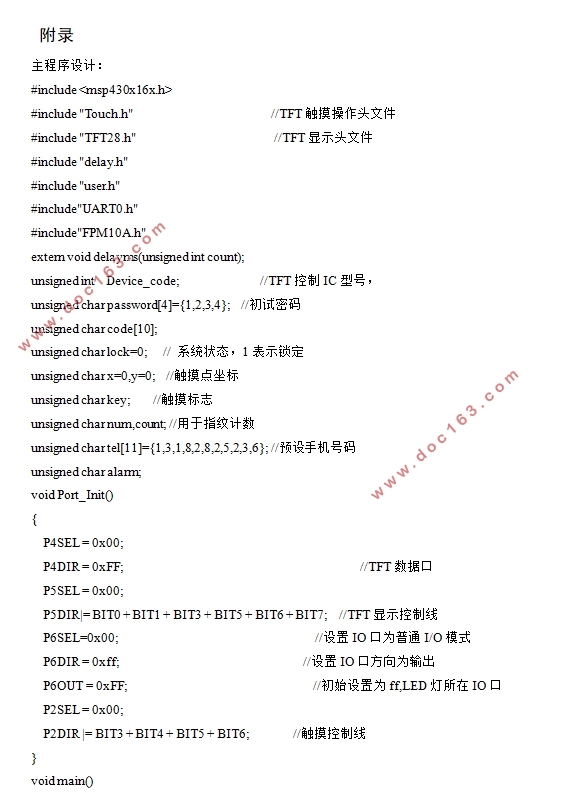一种多功能指纹门禁系统的设计

一种多功能指纹门禁系统的设计(论文12000字)
摘要:生物特征识别技术因其独特的安全性与稳定性,已逐渐成为身份识别的主流趋势,其中,指纹识别是最为成熟的生物特征识别技术之一。本文主要讨论了一种基于MSP430F169单片机的多功能门禁系统,系统通过AS608光学指纹识别模块对用户的指纹进行录入与对比,用户可通过TFT触摸屏选择验证数字密码或指纹的方式对系统进行解锁,系统能够根据验证结果给出声光提示,连续验证失败后能够通过SIM800C GSM模块给预设的手机号码发送报警短信。本系统具备结构简单、使用便利、安全系数高等特点。
关键词:门禁系统; MSP430F169;AS608; TFT触摸屏; SIM800C
A multi-functional fingerprint access control system
Abstract:Because of its unique security and stability, biometric identification technology has gradually become the mainstream of identity recognition. Among them, fingerprint recognition is one of the most mature biometric identification technologies.This article mainly discusses a multi-function access control system based on MSP430F169 single-chip microcomputer. The system uses AS608 optical fingerprint identification module to record and compare the user's fingerprints. The user can unlock the system through TFT touch screen to select the verification digital password or fingerprint. According to the verification result, the acousto-optic prompt can be given. After the continuous verification failure, the SIM800C GSM module can send an alarm message to the preset mobile phone number. System has a simple structure, easy to use, high safety factor. [资料来源:http://www.doc163.com]
Key words:Access Control System;MP430F169;AS608;TFT touch screen;SIM800C
[来源:http://Doc163.com]


目录
1 绪论 1
1.1 研究内容 1
1.2 研究目的与意义 1
1.3论文安排 1
2系统设计方案 2
2.1 总体设计方案 2
2.2 单片机的选择 3
2.3指纹识别模块的选择 4
2.4 显示模块的选择 5
2.5 短信报警模块的选择 6
3 硬件设计 8
3.1 电源电路设计 8
3.2 单片最小系统 8
3.2.1 时钟电路 9
3.2.2 复位电路 9
3.2.3 程序下载与调试电路 10
3.3 指纹模块电路设计 10
3.4 TFT触摸屏电路设计 11
3.4.1 FPC接口电路 11
3.4.2 触摸电路 12
3.4.3 IO扩展电路 12
3.4.4 SD卡接口电路 13
3.4.5 输入输出接口电路 13
3.5 SIM800C模块电路设计 15
3.6 开关电路 16
3.7 蜂鸣器与LED电路 17
4 软件设计 17
4.1 开发环境 17
4.2 主程序 18
4.3 显示与输入程序的设计 19
4.3.1 命令/数据的读写 19
4.3.2 显示程序设计 19
4.3.3 数字的输入 20
4.4 指纹处理程序的设计 20
4.4.2 添加指纹 21
4.4.3 搜索指纹 23 [资料来源:https://www.doc163.com]
4.4.4 清空指纹库 24
4.5 短信报警程序设计 25
5测试与分析 25
5.1系统实物图 25
5.2 操作流程 26
5.3预期效果 28
5.4存在的不足与展望 28
6总结 29
参考文献: 29
致谢 31
附录 32 [资料来源:http://doc163.com]
